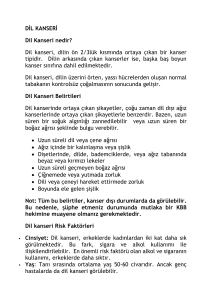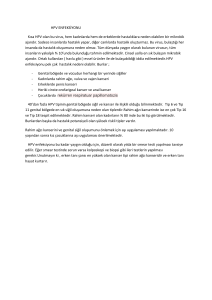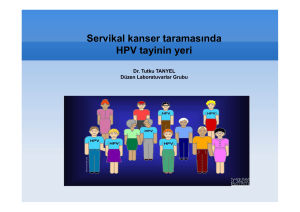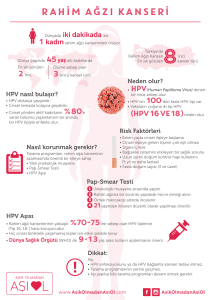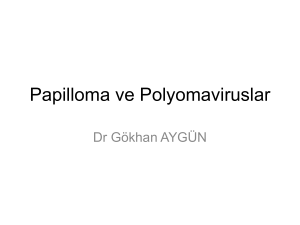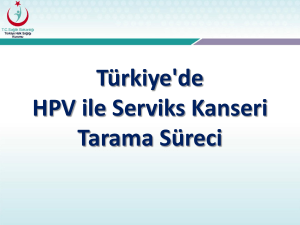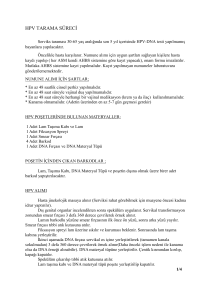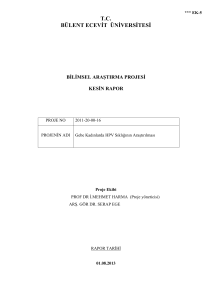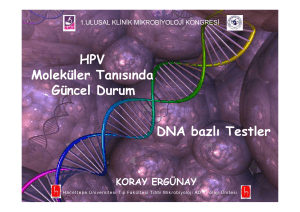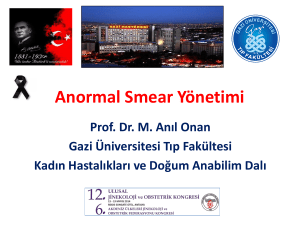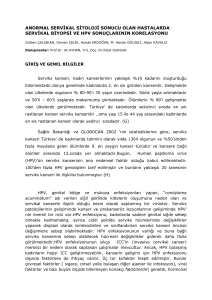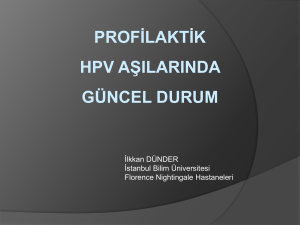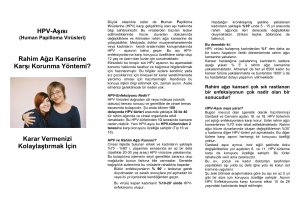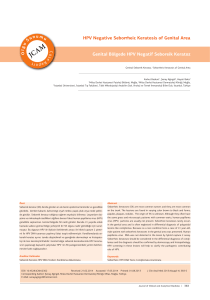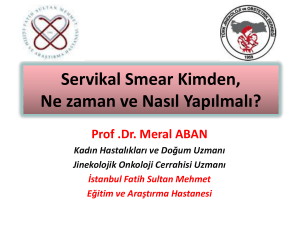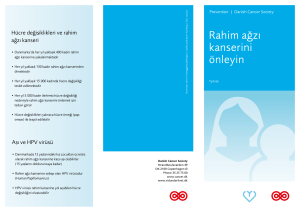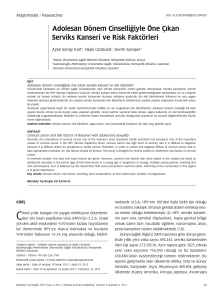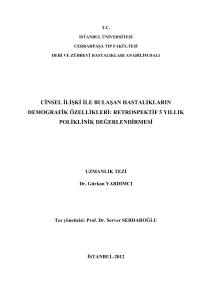Primer Serviks Kanseri Taramas*nda HPV
advertisement
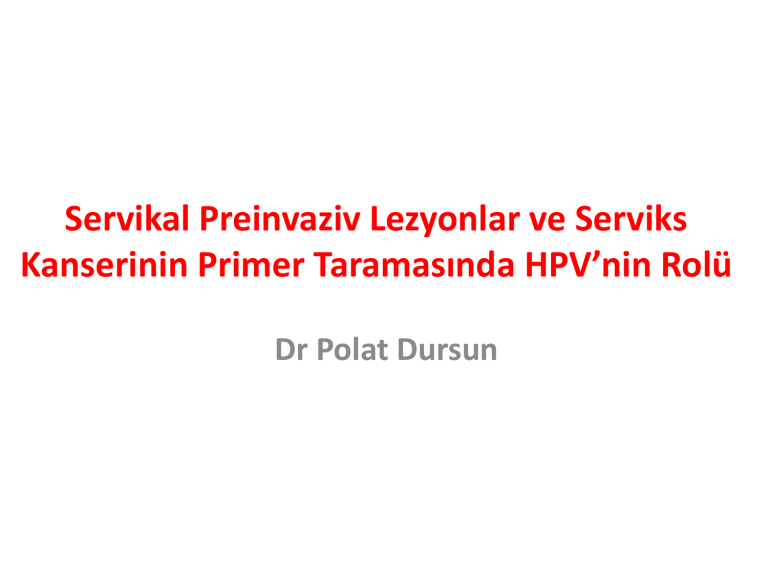
Servikal Preinvaziv Lezyonlar ve Serviks Kanserinin Primer Taramasında HPV’nin Rolü Dr Polat Dursun Sunum planı • Serviks kanseri sitolojik taramasındaki sorunlar • HPV serviks kanseri ilişkisi • Primer Taramada HPV çalışmaları • ATHENA çalışması • Sitolojik anormalliklerin yönetiminde HPV testi Servikal Kanser • • • • > 500 bin yeni vaka /yıl 50% Mortality >99% HPV İlişkili Tamamen önlenebilir bir Kanser – HPV Vaccination, Smoking Cessation • Erken Tanı Mümkün – VIA-VILI / Smear / HPV / Combination / Others – WHO • Eradike Edilebilir bir kanser ! Sitolojik Taramanın Serviks Kanseri Sıklığına Etkisi • 50 yıldır kullanımda • Mortalite ve insidansda %50 düşme • Özellikle gelişmiş ülkelerde başarılı programlar • Sadece 8 Avrupa ülkesinde yerleşik sistem • Ve…serviks kanserlerinden ölüm en iyi ülkelerde bile devam ediyor England- 1971-1995 Sitoloji Tabanlı Taramanın Sorunları • Çok zor ve kompleks bir halk sağlığı hizmetidir. • Bilimsel Yetersizlikler – CIN2+ lezyonlar için tek bir pap-testin sensitivitesi çok düşüktür. – Pap-testin yanlış negatiflik oranı çok yüksektir. – Pap-testin tekrarlanabilirliği düşüktür. – Pap-test servikal adenokarsinom tanısı koymada yetersizdir. Pap Smear Taramasındaki Hatalar • Örnekleme hataları Hücreler örneklenemez Transfer edilemez Korunamaz • Tarama / Yorumlama Hataları Sitolog tarafından yanlış yorumlama Yanlış yönetme Sitoloji Tabanlı Taramanın Sorunları CIN2+ lezyonlar için tek bir pap-testin sensitivitesi çok düşüktür. • Tek bir pap-testin sensitivitesi %50-60’tır. Nanda K, et al, systematic review, Ann Intern Med. 2000;132(10):810-819 • Sık tekrar edilmesi gerekir. • 3 kez negatif sonuç alınmaksızın tarama aralığı 3 yıla çıkarılırsa servikal kanser risk, 3 kat artar. Kitchener HC, Castle PE, Cox JT. Chapter 7: Achievements and limitations of cervical cytology screening. Vaccine 2006;24:S63-70 Sitoloji Tabanlı Taramanın Sorunları Pap-testin yanlış negatiflik oranı çok yüksektir. 2275 servikal kanser vakasının tarama öyküsü: Tarama Öyküsü (%) İtalyan Verisi₁ Kaiser Verisi₂ İsviçre Verisi₃ Taranmadı %62 %56 %64 Normal Sitoloji %14 %32 %24 %24 %13 %7 n=262 n=833 n=1180 Anormal sitoloji & Yetersiz takip 1 Amadori A, et al. Int J Gyn Can 1998, 8; 251-256 2 Leyden WA, et al. J Nat Can Ins 2005, 97; 675-683 3 Andrae B, et al. JNCI 2008, 100; 622-629 Sitoloji Tabanlı Taramanın Sorunları Pap-testin tekrarlanabilirliği düşüktür. • İnter-observer ve inter-laboratuar variabilitesi yüksektir. • Bu variabilite klinik tutarlılığı azaltır. • Eğitim farkı arttıkça variabilite daha da belirginleşir. • Bu durum özellikle taramanın yeni başlatılacağı yerler için önemli. Castle PE et al. ATHENA study. 2011 Lancet Oncol 12:880-90 Sitoloji Tabanlı Taramanın Sorunları Pap-testin tekrarlanabilirliği düşüktür. Oran (%) Lab A Lab B Lab C Lab D Normal 96,2 94,6 91,8 90,1 Anormal 3,8 5,2 8,1 9,9 ASC-US/LSIL 2,1 1,1 1,2 2,3 42,0 51,0 60,5 73,0 CIN2+ lezyonlar için Sitolojinin Sensitivitesi Wright TC et al. Insights from ATHENA. 2013 Sitoloji Tabanlı Taramanın Sorunları Pap-test servikal adenokarsinom tanısı koymada yetersizdir. • Sitoloji tabanlı etkin taramalara rağmen servikal adenokarsinom insidansı artmaktadır. Ault KA et al. 2011 Int J Can. 128, 1344-1353 • AIS özellikle <40 yaş grubunda artmaktadır. Saslow D et al. 2012 CA Can J Clin. 62(3):147-172 • SCC’lerin %70’i HPV16/18’e bağlıyken adenokarsinomların %85-90’ı bu tiplerle ilişkilidir. Katki HA et al. Lancet Oncol 2011;12:663-672 Sitoloji Tabanlı Taramanın Sorunları Pap-test servikal adenokarsinom tanısı koymada yetersizdir. Sensitivite Histoloji (n) Sitoloji HPV CIN3 (254) %52 %92 AIS (16) %63* %88 Adenoca ve Adenosq ca (1) %100 %100 SCC (3) %100 %100 *%25 fark %%25 Castle PE et al. ATHENA study. 2011 Lancet Oncol 12:880-90 Serviks Kanseri Taramasının Dönüşümü HPV Serviks Kanseri İlişkisi HPV Serviks Kanseri Riski Munoz N, et al. Epidemiologic classification of human papillomavirus types associated with cervical cancer. N Engl J Med. 2003;348(6):518-27. HPV Testi • HPV servikal kanserlerin %100’ü için etken ajan 1990lar 2000 2007 2012 2015 Munoz N. Int J Cancer 2004 Aug 20;111(2)278-85 • HPV testleri daha çok klinik kullanıma girdi • İlk metaanalizler HPV testlerinin yüksek sensitivitesini gösterdi • Primer tarama için randomize kontrollü çalışmalar planlandı • İlk tur sonuçlar • Avrupa ve Dünya’da primer taramalar • İkinci tur sonuçlar • Primer taramada önerildi RCTs of HPV testing in screening • POBASCAM study: The Netherlands (Meijer et al., Int J Cancer 2004; Bulkmans et al, Lancet 2007) • Indian Trial (Osmanabad) (Sankaranarayanan et al. NEJM 2009) • ARTISTIC trial: UK (Kitchener et al. Lancet Oncol 2009) • NTCC Italian Study (Ronco et al., Lancet Oncol, 2006; JNCI 2006) • SWEDESCREEN: Swedish trial (Elfgren et al. AJOG 2005; Naucler et al., NEJM 2007; JNCI 2009) • Finnish RCT (Kotaniemi et al., BJC 2005; Eur J Cancer 2008; IJC 2008; Leinonen et al., JNCI 2009) • CCCaST study: Canada (Mayrand et al., IJC 2006; NEJM 2007) • BC RCT (HPV FOCAL): Canada (Ogilvie et al, BJC 2012) HPV Testlerinin Sensitivitesi Metaanalizler HPV testlerinin daha sensitif olduğunu gösterdi Sensitivite Spesivite Sitoloji 53% 97% HPV testi 96% 92% Mayrand MH et al. Int J Cancer 2006 119;615-623 Primer HPV Taraması İlk Tur Sonuçları (10,000’de) CIN3+ lezyonların kümülatif insidansı Birleşik Avrupa verisi Başlangıç testinden itibaren zaman (ay) Dillner, J. et al. BMJ 2008;337:a1754 Negatif HPV Testi Sonrası CIN3 ve Servikal Kanserden Ölüm Oranları The ATHENA Study The ATHENA Study • ATHENA is the largest prospective cervical cancer screening study in the U.S. • Enrolled 47,208 women ≥21 years undergoing routine cervical cancer screening in the U.S. – 61 clinical sites in 23 states and 4 clinical laboratories • Served as the FDA registrational study for the cobas® HPV Test for: – ASC-US management (approved in 2011) – Cotesting with cytology for screening (approved in 2011) – Primary screening (approved in 2014) Wright et al. Am J Clin Pathol 2011;136:578-586 ATHENA Trial Design • Specifically designed to demonstrate the performance of HPV testing in cervical screening in the U.S. – The ATHENA population was representative of a U.S. screening population in demographics, cytology distribution, and HPV prevalence – Both cytology and HPV testing (with genotyping) performed on all women – Rigorous disease ascertainment was achieved • All women who screened positive for either test (both Pap+ and HPV+) were taken to colposcopy • Histology determined by consensus of expert pathologists Wright et al. Am J Clin Pathol 2011;136:578-586 Cytology Results and Prevalence of hrHPV in ATHENA Pap Test Result NILM Eligible Subjects ≥25 Years N=40,944 % (n) 93.5 (38,397) ASC-US 4.0 (1632) >ASC-US 2.4 (986) LSIL 1.9 ASC-H 0.1 HSIL 0.3 Squamous Cell Carcinoma AGCa, b aAGC <0.1 (Atypical Glandular Cells) includes: AGC - Endocervical, AGC - Endometrial, and AGC - Not Otherwise Specified Favor Neoplastic includes: AGC - Endocervical - Favor Neoplastic and AGC - Favor Neoplastic bAGC, HPV Prevalence in ATHENA HPV+ Age Groups (Years) HPV16+ HPV18+ ATHENA % NMHPVPR* % ATHENA % NMHPVPR* % ATHENA % NMHPVPR* % Overall Evaluable Primary Screening Subjects 10.5 14.2 2.1 3.1 0.8 0.9 25-29 21.1 21.8 5.3 5.2 1.6 1.4 30-49 9.4 11.5 1.7 2.2 0.7 0.7 ≥50 6.0 6.9 0.8 1.3 0.4 0.5 *New Mexico HPV Pap Registry; assumed that carcinogenic HPV+ (HPV 16, 18, 31, 33, 39, 45, 52, 56, 58, 59, and 68) in NMHPVPR was equivalent to HPV+ (HPV 16, 18, 31, 33, 35, 39, 45, 51, 52, 56, 58, 66, and 68) in ATHENA Wheeler C et al. Int. J. Cancer: 2013;132:198–207 ATHENA Patient Flow Cross-sectional Phase for Primary HPV Effectiveness Women ≥25 years visiting for routine exam n=42,209 40,944 evaluable women Normal Pap and hrHPV (-) ≥ASC-US or hrHPV (+) Colposcopy n=8073 (86%) Randomized & proceeded to colposcopy n=892 (86%) Not Randomized ≥CIN2 ≥CIN2=431 Exit study Wright et al. Am J Clin Pathol 2011;136:578-586 No ≥CIN2 ATHENA Patient Flow 3 Year Follow-up Phase for Safety Evaluation Exited after Baseline n=1359 Colposcopy n=8073 N=6210 ≥CIN2 No ≥CIN2 ≥CIN2=79 Year 1 visit ≥CIN2=35 Year 2 visit ≥CIN2=42 Year 3 exit colposcopy n=4063 Exit study Wright et al. Am J Clin Pathol 2011;136:578-586 Performance Comparison of Three Screening Strategies ASC-US Triage Strategy Routine screening Cytology Negative Pap ASC-US Routine screening Negative HPV test Positive LSIL/HSIL COLPOSCOPY COLPOSCOPY This strategy is a recommended in US Guidelines for women 21+ every three years Cotesting Strategy Routine screening Cytology NILM / HPVASC-US / HPV- Cotesting 12 months NILM / HPV+ HPV Test 31 33 35 39 45 51 52 56 58 59 66 16 68 OR HPV 16/18 genotyping ASC-US / HPV+ >ASC-US 18 COLPOSCOPY This strategy is recommended in US Guidelines for women 30+ every five years as the preferred option HPV with Genotyping and Reflex Cytology Strategy Routine screening HPV− 31 33 35 39 45 51 52 56 58 59 66 16 68 NILM 12 other hrHPV+ Cytology 18 ≥ASC-US hrHPV COLPOSCOPY HPV16/18+ COLPOSCOPY hrHPV=high risk HPV Follow-up in 12 months Comparisons for Women 25+ • ASC-US Triage Strategy (ages 25+) • Cotesting Strategy (ages 25+) – Cytology with Reflex HPV Strategy (ages 25-29) – Cotesting Strategy (ages 30+) • HPV with Genotyping and Reflex Cytology Strategy (ages 25+) Comparison to ASC-US Triage CIN3 Relative Sensitivity1 % Relative Specificity1 % ASC-US Triage 1.00 1.00 Cotesting† with 16/18 Genotyping 1.28* 0.99* HPV with Genotyping and Reflex Cytology 1.40* 0.99* Strategy Data from Medical Devices Advisory Committee Microbiology Panel Meeting: Sponsor Executive Summary Adjusted results 1Relative to Cytology with Reflex HPV Strategy *Statistically significant differences compared to Cytology with Reflex HPV Strategy †Cotesting: Cytology with ASC-US triage in women 25-29, Cotesting with cytology and HPV in women 30+ Comparison to ASC-US Triage CIN3 Strategy PPV % NPV % ASC-US Triage 11.58 99.41 Cotesting† with 16/18 Genotyping 11.04 99.52* HPV with Genotyping and Reflex Cytology 12.25 99.58* Data from Medical Devices Advisory Committee Microbiology Panel Meeting: Sponsor Executive Summary Adjusted results *Statistically significant difference verses Cytology with Reflex HPV Strategy †Cotesting: Cytology with ASC-US triage in women 25-29, Cotesting with cytology and HPV in women 30+ ATHENA- Find disease missed by cytology cobas® HPV Test In the ATHENA study more ≥CIN3 cases were detected by 252 cobas® HPV Test in overall population than liquid-based cytology LBC 146 0 50 100 False Negative Cytology 150 200 250 Superior sensitivity for ≥CIN3 allows for the identification of more women with high-grade cervical dysplasia than cytology. Castle, PE, Lancet Oncol. Doi: 10.1016/S1470-2045(11)70188-7 274 3-Year Cumulative Risks for ≥CIN3 Primary Screening Population (≥25 Years) 30 HPV 16+ CIR ≥CIN3 (%) 25 20 15 HPV 18+ HPV+ 10 Other 12 hrHPV+ 5 HPV- 0 Baseline Year 1 Year 2 Year 3 The risk of ≥CIN3 for women who tested HPV16+ at baseline was approximately 25% Gynecologic Oncology 2015 Reliability of a Negative Test Primary Screening Population (≥25 Years) CIR ≥CIN3 (%) Pap Negative HPV DNA Negative The lower risk of disease of an hrHPV DNA negative result at Baseline confirms the safety of a negative hrHPV DNA result over 3 years Gynecologic Oncology 2015 ASC-US Triage (detection of ≥CIN2) cobas® HPV Test (hrHPV) Point estimate 95% CI Sensitivity 90.0% (72/80) 81.594.8 Specificity 70.5% (1,056/1,498) 68.172.7 PPV 14.0% (72/514) 12.815.3 NPV 99.2% (1,056/1,064) 98.699.6 Optimal balance of sensitivity and specificity for ASC-US triage. Stoler et al. Am J Clin Pathol 2011;135:468-475 US Guideline: ASC-US Triage HPV DNA Testing Repeat Cytology @ 1 Year Acceptable Negative Routine Screening (Cytology in 3 years) Preferred ≥ ASC HPV Positive HPV Negative Colposcopy In women with ASC-US cytology, triage with HPV testing is preferred. Repeat Co-testing @ 1 year Manage per ASCCP Guideline The cobas® HPV Test provides 93.5% sensitivity for the detection of ≥CIN3 lesions in women with ASC-US cytology Massad LS et al. J Low Genit Tract Dis 2013;17:S1 US Guideline: Co-Testing HPV DNA Typing Repeat Cotesting Acceptable @ 1 Year Acceptable Cytology Negative ≥ ASC or and HPV Negative HPV Positive Repeat Co-testing @ 3 years HPV 16 or 18 Positive HPV 16 and 18 Negative Colposcopy Repeat Co-testing @ 1 year Manage per ASCCP Guideline Manage per ASCCP Guideline In women ages 30+ with normal cytology, HPV DNA testing with 16/18 genotyping allows for closer follow-up of women at highest risk, while allowing women at lower risk to avoid immediate followup. The cobas® HPV Test allows for simultaneous genotyping of HPV 16 and 18 for more efficient management of HPV positive women with normal cytology. Massad LS et al. J Low Genit Tract Dis 2013;17:S1 Sitolojik Anormalliklerin Yönetiminde HPV Yetersiz Sitoloji Sitoloji Negatif fakat EC/TZ Komponenti Yetersiz >30 y , Sitoloji Normal Fakat HPV + ASCUS Yönetimi 21-24 y LSIL Yönetimi LSIL Yönetimi CIN1 Takip CIN 2/3 Takip HPV Taramalarında Tartışmalar • Aşırı HPV pozitif, sitoloji normal olguların tesbiti • Spontan gerileyecek lezyonların aşırı tesbiti 1. Tarama yaşı 2. İkinci tur verileri POBASCAM, Swedescreen, ARTISTIC,NTCC 3. Gereksiz kolposkopilerin önüne geçmek için risk değerlendirmesi Refleks sitoloji/ HPV genotiplendirme / Moleküler testler Yaş • Taramaya Başlama yaşı >30 olmalı Cuzick J et al. 2006 Int J Cancer At What Age Should We Initiate Primary HPV Screening • Current U.S. screening guidelines do not recommend cotesting for women 25-29 years of age1 • However, there is a high burden of CIN3 in women 25-29 years and cytology performs poorly in this age group2 • In 2013 Kaiser Permanente, N. California reviewed their registry data and decided to begin cotesting at age 25 years3 1. Screening for Cervical Cancer, Topic Page. March 2012. U.S. Preventive Services Task Force downloaded from: http://www.uspreventiveservicestaskforce.org/uspstf/uspscerv.htm ; Schiffman and Solomon, NEJM, 2013; 369: 2324-2331 2. Martin-Hirsch et al. BJOG. 2007 Apr;114(4):408-15 3. Katki et al. Lancet Oncol. 2011 Jul;12(7):663-72. HPV by Age Group % Having HPV by cobas® HPV Test ATHENA 21.1% Age Group . Wright et al. Am J Obstet Gynecol. 2012 Jan;206(1):46.e1-46.e11 HPV 16/18 by Age Group ATHENA % Having HPV by cobas® HPV Test HPV 16 Age Group Wright et al. Am J Obstet Gynecol. 2012 Jan;206(1):46.e1-46.e11 HPV 18 HPV 16/18 vs ≥ASC-US ATHENA HPV 18 % Positive HPV 16 Age Group Wright et al. Am J Obstet Gynecol. 2012 Jan;206(1):46.e1-46.e11 Abnormal Pap ≥CIN3 by Age Group ATHENA 37% Percentage of ≥CIN3 cases 40% 28% 30% 17% 20% 10% 8% 10% 0% 21-24 25-29 30-39 Age Group Wright et al. Am J Clin Pathol 2011;136:578-586 40-49 >50 Proportion of Women with ≥CIN3 Who Have Negative Cytology (NILM) ATHENA Proportion of ≥CIN3 (%) In ATHENA, 57.3% of women 25-29 years of age with CIN3 or greater had a negative cytology. 42.7 53.3 61.7 Age Percentages shown are for hrHPV+ women with ≥CIN3, N=252 Wright et al. Am J Obstet Gynecol. 2012 Jan;206(1):46.e1-46.e11 ≥ASC-US 72.2 NILM İkinci Tur Tarama Verileri POBASCAM, Swedescreen, ARTISTIC,NTCC RCT 94.370 Women HPV or Cytology Screening HPV ile tarananlar Smear ileTarananlar CIN2 CIN3/AIS Kanser CIN2 CIN3/AIS Kanser 1. Tur 108 98 6 54 47 8 2. Tur 8 8 0 15 17 9 116 106 6 69 64 15 Toplam Ronco et al, Lancet Oncol, 2010 3-Risk Değerlendirmesi » Refleks sitoloji • Düşük risk • Orta risk (6% CIN3+ over 5 years) • Yüksek risk (17% CIN3+ over 5 years) » HPV genotipi • HPV 16/18 ve diğer » Moleküler testler (p16, Ki67, mRNA ) Rijkaart DC/ Int J Cancer (2012) Katki HA, Lancet Oncology 2011 M. Arbyn et al. / Vaccine 30S (2012) F88– F99 Co-Test / Sadece HPV ? 2012 Rehberleri Co-Test • Bu rehberler 2011 ve öncesi yayımlardan üretilmişti Ama…. Karşılaştırma Sito ve HPV vs. Sadece HPV Sito ve HPV vs. Sadece HPV Hedef Göreceli Sensitivite Göreceli Spesifite Çalışma Sayısı CIN2+ 1,05 0,95 10 CIN3+ 1,02 0,93 6 M. Arbyn et al. / Vaccine 30S (2012) F88–F99 Primer HPV Taraması Kolposkopiyi Arttırır • Cumulative Cervical Cancer Incidences for negative initial tests: Negative cytology; Negative HPV test; 3,5 years 15.4 / 10⁵ 4.6 / 10⁵ 5,5 years 36.0 / 10⁵ 8.7 / 10⁵ NCI, ASCCP, ACS, SGO,EU, ACOG https://www.sgo.org/newsroom/news-releases/medical-societies-recommendconsideration-of-primary-hpv-testing-for-cervical-cancer-screening/ Yeni Algoritma HPV Taramalarının Ek Faydaları • Objektif, merkezi, otomatize, laboratuarlar arası tutarlı, kalite kontrolü kolay • Daha uzun tarama aralığı – Taramaya katılımda bireylerin uyum artışı – HPV aşılarının etkisi – Gelecek tarama stratejileri • Kendi kendine HPV-Self HPV • Diğer kanserlere HPV’nin etkisi – Baş-boyun yüzde 30 Hangi HPV Testi ?? 125 HPV Testi Mevcut HC2, GP5+/6+ PCR-EIA, Abbott RT hrHPV test, cobas 4800 HPV test, PapilloCheck HPV-Screening test, BD Onclarity HPV assay and the HPV-Risk assay M. Arbyn, P. J. F. Snijders, C. J. L. M. Meijer, J. Berkhof, K. Cuschieri, B. J. Kocjan and M. Poljak Clin Microbiol Infect 2015 Disease Progression Viral DNA consistently present throughout disease progression cobas HPV Test clinical cut-off mRNA expression elevates only after disease has progressed Identification of high-risk HPV DNA allows for the earliest possible identification of women who are at increased risk of cervical cancer and its precursors. Nat Rev Cancer© Nature Publishing Group jgo.ascopubs.org JGO – Journal of Global Oncology. 2017 Kaiser Permanente California 5 Yılda CIN2/CIN3 ve Kanser Gelişme Riski JNCI, 2014 Conclusions • Sitolojik tarama başarılı fakat limitasyonları var • HPV temelli primer serviks kanseri taraması ASCUS-triage yaklaşımına göre Daha sensitif Benzer PPV Daha iyi NPV • Pozitif Cobas test riskli hastaların belirlenmesinde daha etkili • Negatif Cobs testi 3 yıl içinde CIN3 üzeri lezyonların gelişmeyeceğini daha iyi garanti eder • Primer HPV taraması yakın gelecekte rutine girebilir.
